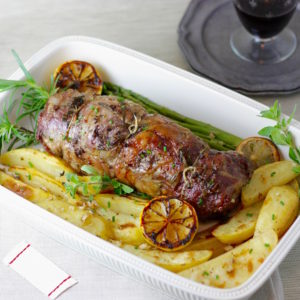Greek Roast Leg of Lamb with Lemon Potatoes

Prep time
Cook time
Total time
A traditional Greek recipe served for Easter and as lovely Spring Sunday dinner
Author: Marilena Leavitt
Recipe type: Main Course
Cuisine: Greek
Serves: 8
Ingredients
- 3-3½ lbs. boneless leg of lamb, butterflied (see note)
- 3 TBSP. Greek olive oil
- 1 small shallot, minced
- 3 garlic cloves, minced
- 1 TBSP. fresh rosemary leaves, finely chopped
- 1 TBSP. fresh thyme leaves, finely chopped
- ½ tsp. dried Greek oregano
- ¼ tsp. red pepper flakes
- ¼ tsp. freshly ground pepper
- 1½ tsp. sea salt
- --- zest of one small lemon
Instructions
- Place the leg of lamb on a cutting surface and trim most internal fat and any excess connective tissue. Do not trim much of the outside fat, however, as it imparts moisture and flavor to the rest of the cut. Spread the lamb as flat as possible and, with a sharp boning knife, make small cuts along the thicker parts of the meat as needed, so as to get an even thickness. This will make rolling easier later. You can also ask your butcher to butterfly it for you. Carefully score the meat on the inside, so that the herb mixture can seep in to all of the scorings and soak up all the flavor while roasting. Make sure not to score all the way down and cut the outer layer of meat – just small ¼” inch cuts on the inside only will do.
- Prepare the “wet” rub: In a small skillet set over medium-low heat, heat the olive oil and add the shallot, garlic, rosemary and thyme. Cook for two minutes and then add the oregano, pepper flakes salt & pepper and lemon zest. Cook for a couple more minutes (making sure not to burn the garlic) and then remove it from the heat and let it cool.
- Pour two thirds of the rub over the inner side of the butterflied lamb. Spread it all over the meat and push it into the scores you made. Carefully roll tightly into a log along the longest side. Tie the roll with some kitchen twine at 1½” intervals, to make sure it does not open up while roasting. Let it sit in the refrigerator (uncovered, so we get a crisp crust) for at least two hours or, even better, overnight. A longer stay with the rub will give the lamb a better flavor and texture.
- Take the lamb out of the refrigerator and allow it to sit at room temperature for 30 minutes. Preheat the oven to 275° F. Adjust oven rack to the lower middle position. Line a rimmed baking sheet with heavy-duty foil. Place the lamb on the baking sheet and transfer the sheet to the oven. Roast for about 1¼ to 1½ hours, depending on the thickness and the size of the leg or lamb. The best way to ensure proper doneness is to use an instant-read thermometer inserted into the thickest section of lamb – it should register between 130°F to 135°F, for a perfect pink center. Remove the lamb from oven and let it rest, loosely covered with aluminum foil, for about 15 minutes.
- While the lamb is resting, increase the oven temperature to 450°F. Return the lamb to the oven and roast it for about 8-10 minutes or until the exterior is golden brown and crisp. Remove it from the oven, place it on a cutting board, and, let it rest for about 5-8 minutes. Remove the twine and slice the lamb into thin slices. Serve with roasted potatoes.
Notes
In Greece, lamb is usually younger and less fatty. Australian or New Zealand are good alternatives and if you are after richer, gamier flavors look for American lamb!
Recipe by Marilena's Kitchen at https://marilenaskitchen.com/greek-roast-leg-of-lamb-with-lemon-potatoes/